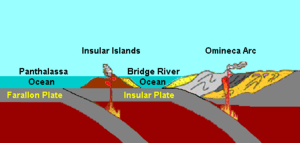Insular Islands
The Insular Islands were a giant chain of active volcanic islands somewhere in the Pacific Ocean during the Cretaceous period that rode on top a microplate called the Insular Plate, beginning around 130 million years ago. The Insular Islands were surrounded by two prehistoric oceans, the Panthalassa Ocean to the west and the Bridge River Ocean to the east. About 115 million years ago, these islands collided with the North American continent, fusing onto the North American Plate and closing the Bridge River Ocean during the Mid-Cretaceous time.

The Insular Islands formed at least 210 million years before the collision. Like the earlier Intermontane Islands, the large size of the islands prevented them from being pushed under the North American Plate. Instead, the Insular Islands were crumpled and crushed along the shoreline of North America to become part of the continent. The Insular Plate stopped subducting under North America; the subduction zone moved to the Farallon Trench further westward.[1] The rocks that comprised the Insular Islands now form a large geologic feature along the coast of North America known as the Insular Belt.
See also
References
- "The Coast Range Episode". The Burke Museum of Natural History and Culture. Retrieved 1 January 2010.